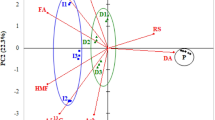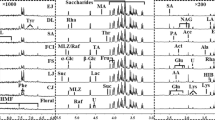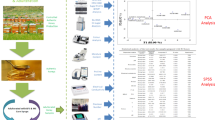Abstract
Amino acid analysis of honey by high-performance liquid chromatography (HPLC) was used first to discriminate different botanical origins and then to combat adulteration. Pure honeys of seven selected floral varieties were examined. A principal component analysis (PCA) was carried out on the results after selection of the most discriminating parameters. Lavender honeys were thus perfectly characterized, but complete satisfaction was not obtained with the six other varieties. This method (analysis by HPLC and statistical processing by PCA) enabled us to detect the addition of sugar syrup to rape and fir honeys.









Similar content being viewed by others
References
Copa-Cogeca (1997) Dossier sur les fraudes dans le secteur honey (Frauds in the honey sector)
Kerkvliet J, Meijer H (2000) Apidologie 31:717–726
Kerkvliet J, Shrestha M, Tuladar K, Manandhar H (1995) Apidologie 26:131–139
Doner LW, White JW (1977) Science 891–892
White JW, Doner LW (1978) J Ass Off Anal Chem 61(3):746–750
White JW, Winter K (1989) J AOAC Int 72(6):907–911
White JW (1992) J AOAC Int 75(3):543–548
White JW, Winter K, Martin P, Rossman A (1998) J AOAC Int 81(3):610–619
Martin GJ, Martin ML (1995) Annu Rep NMR Spectrosc 31:81–104
Martin GJ, Naulet N (1988) Fresenius J Anal Chem 332:648–651
Lindner P, Bermann E, Gamarnik B (1996) J Agric Food Chem 44:139–140
Giraudon S, Danzart M, Merle MH (2000) J AOAC Int 83(6):1401–1409
Maubert C, Guerin C, Maubon F, Martin GJ (1988) Analusis 16(8):434–439
Casabianca H, Graff JB (1994) J Chromatogr 684:360–365
Casabianca H, Perruchietti C, Jame P, Grenier C, Cotte JF, Bertrand MC, Kustner D (2000) Ann Fals Exp Chim 951:179–188
Baker HG, Baker I (1986) Plant System Evol 151:175–186
Wunnachit W, Jenner F, Sedgley M (1992) Int J Plant Sci 153:419–420
Baker HG, Baker I (eds) (1983) The biology of nectaries. Columbia University Press, New York, pp 126–152
Inouye DW, Waller GD (1984) Ecology 65(2):618–625
Dress WJ, Newell SJ, Nastase AJ, Ford JC (1997) Am J Bot 84(12):1701–1706
Lanza J, Vargo EL, Pulim S, Chang YZ (1993) Env Entomol 22:411–417
Sing RP, Sing PN (1992) J Apic Res 31:128–133
Sing RP, Sing PN (1996) Apidologie 27:21–28
Marshall T, Williams KM (1987) Anal Biochem 167:301–303
Maurizio A (1951) Bee World 32(1):1–5
Bergner KG, Koromi J (1968) Z Bienenforsch 9:182–184
Hahn H (1970) Dissertation. Universitat Stuttgart, Stuttgart
Petrov V (1974) J Apic Res 13(1):61–66
Tillmans J, Kiesgen J (1927) Z Unters Lebensm 53:131–137
Schuette HA, Templin V (1930) J Assoc Off Agric Chem 13:136–142
Komamine A (1960) Acta Chem Fenn B33:185–187
Petrov V (1971) J Agric Res 10(3):153–157
Ought CS (1969) J Food Sci 34:228–430
Michelotti P, Margheri G (1969) Sci Aliment 15(7):179–180
Biino L (1971) Riv Ital Essenze Profumi 53(2):80–84
Davies AMC (1975) J Apic Res 14(1):29–39
Davies AMC (1976) J Food Technol 11:515–523
Anklam E (1998) Food Chem 63(4):549–562
Gilbert J, Sheperd MJ, Wallwork MA, Harris R G (1981) J Apic Res 20(2):125–135
Pirini A, Conte LS, Francioso O, Lercker G (1992) J High Resolut Chromatogr 15:165–170
Chaves Das Neves HJ, Noronha JP (1995) Fresenius J Anal Chem 352:783–787
Oh CH, Kim JH, Kim KR, Brownson DM, Mabry TJ (1995) J Chrom A 15(2):91–96
Palowska M, Amstrong DW (1994) Chirality 6:270–276
Perez Arquillue c, Herrera Marteache A (1987) Alimentaria 24:67–71
Perez C, Conchello P, Arino A, Yanguela A, Herrera A (1989) Sci Aliment 9:203–207
Gratzfeld-Huesgen A (1999) Technical note, Agilent Technologies
Smith LL, Lanza J, Smith GC (1990) Ecology 71:107–115
Koptur S (1994) Biotropica 26:276–284
Baker HG, Baker I (1973) Nature 241:543–545
Bouseta A, Collin S, Dufour JP (1992) J Apic Res 29:89–94
White JW (1978) J Apic Res 17(2):89–93
Cotte JF (2003) These de l’Universite Lyon 1 n° d’ordre:33–2003
Author information
Authors and Affiliations
Corresponding author
Rights and permissions
About this article
Cite this article
Cotte, J.F., Casabianca, H., Giroud, B. et al. Characterization of honey amino acid profiles using high-pressure liquid chromatography to control authenticity. Anal Bioanal Chem 378, 1342–1350 (2004). https://doi.org/10.1007/s00216-003-2430-z
Received:
Revised:
Accepted:
Published:
Issue Date:
DOI: https://doi.org/10.1007/s00216-003-2430-z




